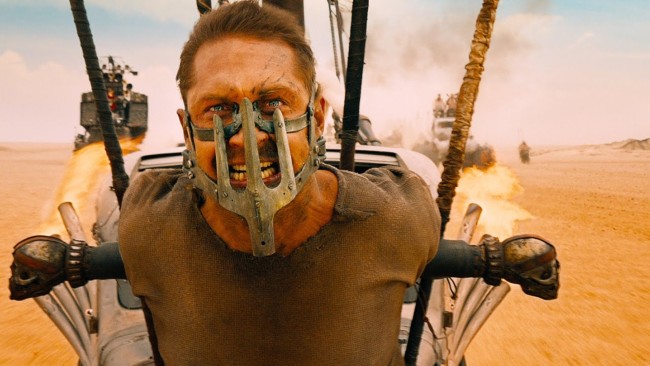Nothing loses me quicker than a movie that opens with an overly-choreographed sequence of bombast that tells me absolutely nothing about the characters involved. Even movies that I ultimately enjoy run the chance of briefly mitigating my enthusiasm when they ambush me with a walloping migraine rather than a quick and efficient dose of riveting character work or compelling storytelling. Some examples: Kingsman, The Avengers: Age of Ultron, the original Conan the Barbarian, and so on. I need something more. Not just the same ol’ preordained combination of punch-punch, kick-kick—a smattering of jabs and perfunctory quips punctuated by explosions one-two-three. In short: I have an allergic reaction to set pieces dictated by the camera’s divine placement.
When I can’t invest in the characters, settings, or rules of the game all that remains are low stakes, and when stakes are low: I simply don’t give a shit.
What I DO give a shit about is Mad Max: Fury Road.
I give plenty of shits.
As far as openers go, Mad Max isn’t any different from the movies listed above. Director George Miller literally cuts to the chase and barrels head first into a scene—cranked up at some ungodly frame rate—where a herd of albino-looking skinheads stampede after our titular Max—a scene that simultaneously braces us for the blitzkrieg ahead. From there on out the movie careens with the reckless freneticism of a methed-up War Boy. Miller refuses to squander his allotted two-hours by mauling us with exposition. Other than a handful of details—choice words played over VO, and a flashback that lasts several frames at a time—there’s no 101 study of the lay of the land, no contrived Q&As of how the world functions, who its inhabitants are, what their tragedies are, nothing as in-depth or dumbfounding as the Marvel movies or the latest Godzilla flick or even Guillermo Del Toro’s Pacific Rim. Whereas their approach was literal and told through “tell-heavy” close-ups and self-indulgent dialogues, Miller tucks away his secrets in the background, in passing mise-en-scenes, in errant details. Like the cortege of “milk maids” or The Bullet Farmer’s bullet-lined gums. Miller isn’t so obnoxious about his world-building, not like the aforementioned Marvel flicks, all of which bury us in an avalanche of apologetic clarification, like, “Hey, we know—and fear (we most certainly do that, too)—that this shit is topsy-turvy gibberish steeped in bullshit mythos you don’t understand or even care to understand, and we’re totally super twitchy and financially concerned that our product is weird and inexplicable so here you go, here’s everything spoon fed, blocks and blocks of reason and justification. Yeah…I hope that’s enough…is it…?”
Watching Mad Max, you quickly learn just how unapologetic Miller can be.
He refuses to condescend.
I’ve read several reviews—glowing reviews, mind you, geysers of unremitting bliss—that have accused Miller of shallow storytelling. Stephen Whitty of The Newark Star-Ledger back-handedly wrote: “Flaws in the story—some easy political posturing, too many shallow characters—can’t even come close to touching George Miller’s strengths: a nightmarish visual imagery, an easy command of…” and so on. I call bullshit. Miller’s world is fully developed. It’s drawn with impeccable detail, and has the feeling of a realm fully explored by its creator. As revealed by an interview conducted by Katey Rich for Vanity Fair, Miller devised meticulous backstories for every character, every car, every tribe and feud and political and social system. He roamed this fuel-less world aimlessly and wholly, like a Wim Wenders angel, and applied all that he witnessed—and its ethos—to the script with Darwinian reserve. This post-apocalyptic wasteland has been the status quo for four or five decades now, it’s hard to believe that characters would be haranguing each other—as well as the audience—with the ins and outs of every single happening.
My concern is that this will strike some—especially those who’re accustomed to a steady diet of “tell don’t show” blockbusters—as lazy screenwriting, when it’s anything but. My favorite movies are those that push me to flex my brain muscles and trigger a series of little pops and snaps and connections that band together to bully and bruise my imagination into producing its own back stories. For instance: How in the fuck did Charlize Theron’s Furiosa—easily the most badass lady warrior since Tarantino and Thurman’s The Bride—lose her arm? Maybe, like Immortan Joe’s stable of sex slaves, she, too, was a bride of servitude, who maimed herself in order to escape a life of sexual exploitation. The movie never addresses it explicitly, however, there are enough bread crumbs along the way that if you follow them long enough you’ll eventually recover the entire loaf.
Ignore Abrams, ignore the latest Hobbit trilogy. This is how you build worlds. It’s a mistake to think we need (or that we even deserve) to fully understand EVERYTHING!. There’s a tacit agreement between the characters and their grand architect, a secret agreement that grants us heft through mystery. It’s a privilege to visit a land in which we’re not necessarily welcome. In fact, it’s that very intrusion that twists us so high with euphoria—the act of getting away with it, of flirting so closely with the maelstrom of violence and adrenaline typical of a Mad Max movie. If Miller had revealed to me the mythology in all its full-frontal starkness, my imagination would have gone limp.
As Ernest Hemingway once wrote: “If a writer of prose knows enough about what he is writing about, he may omit things that he knows and the reader, if the writer is writing truly enough, will have a feeling of those things as strongly as though the writer had stated them. The dignity of movement of an iceberg is due only eighth of it being above water.”







